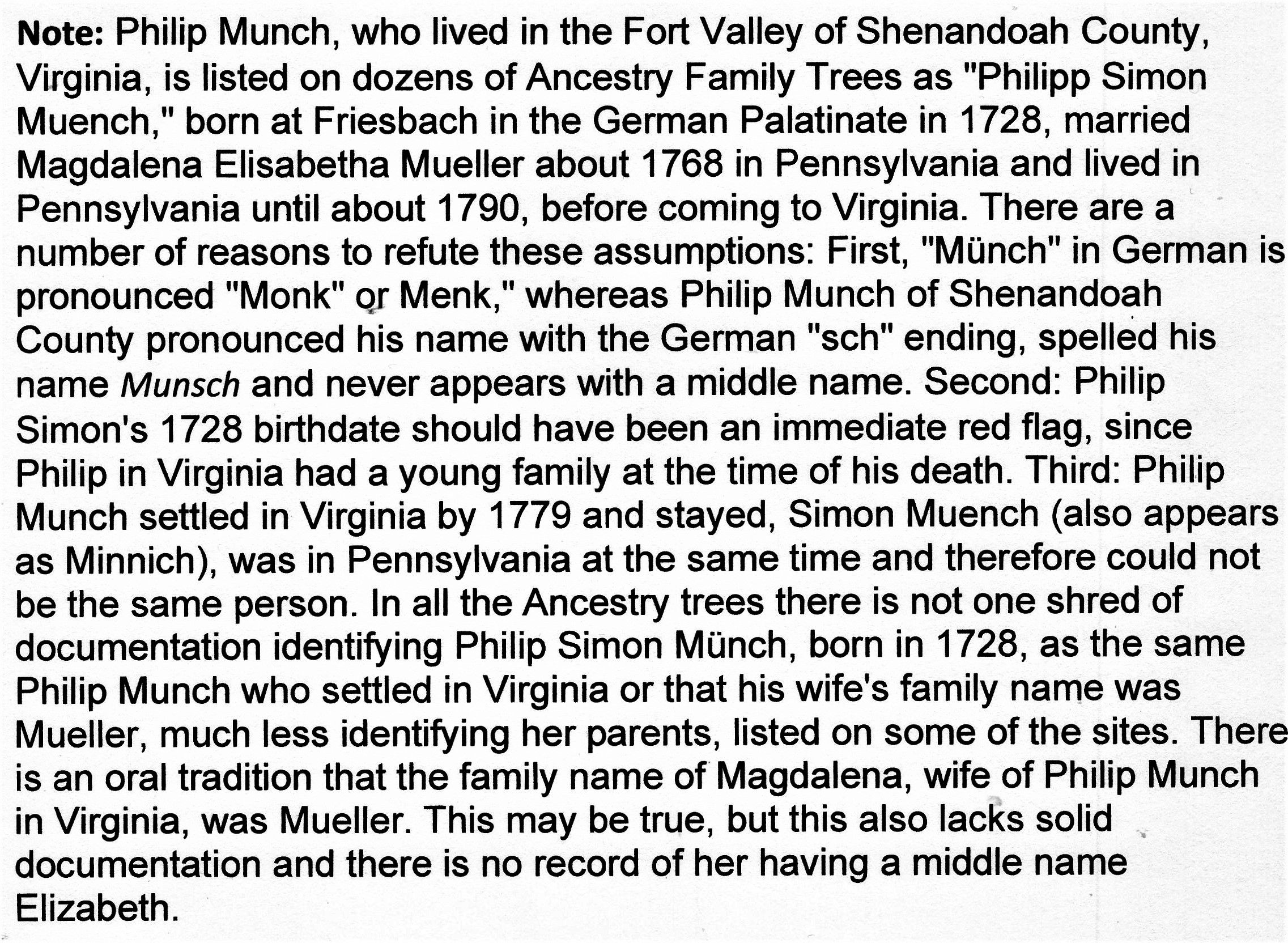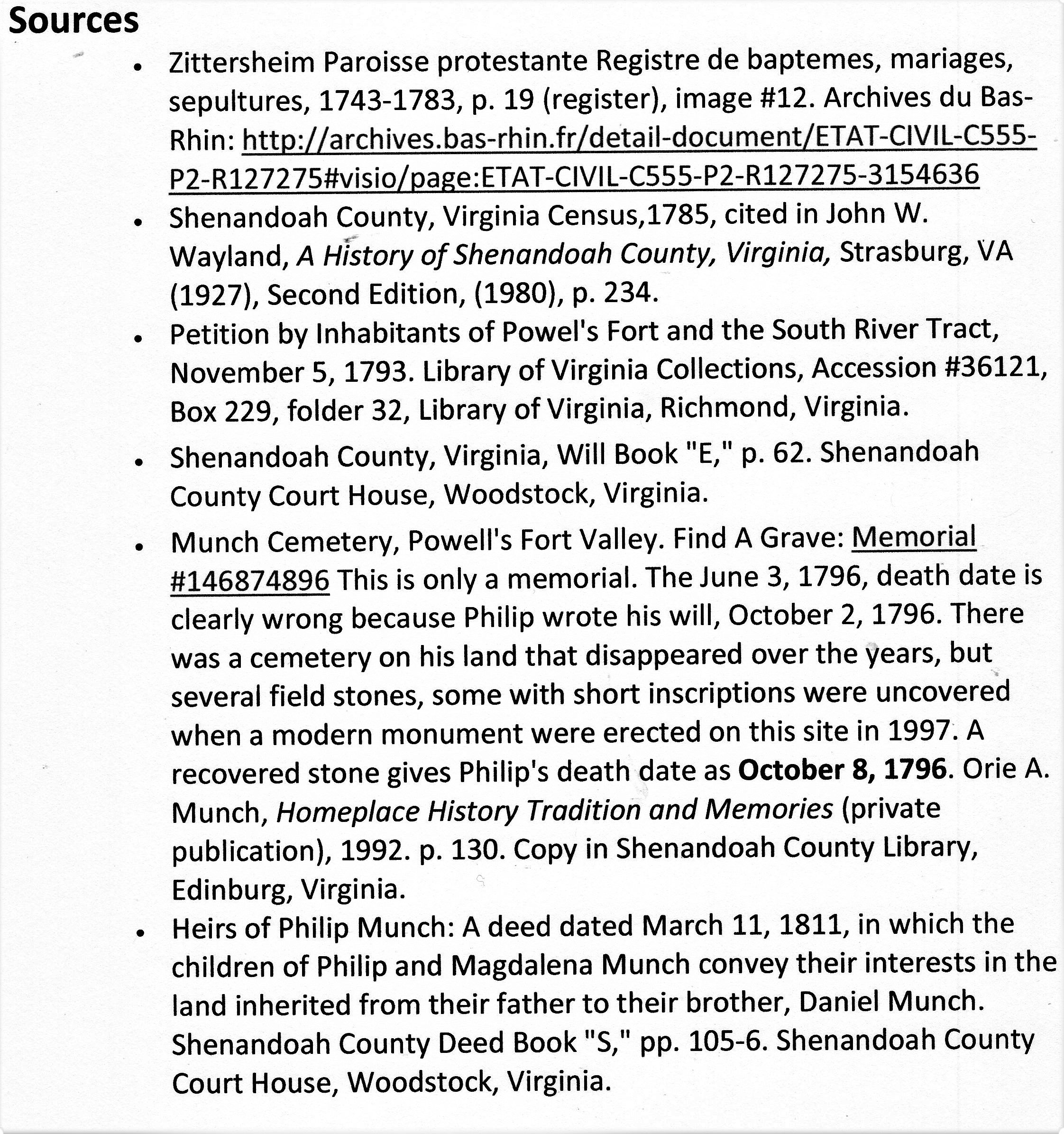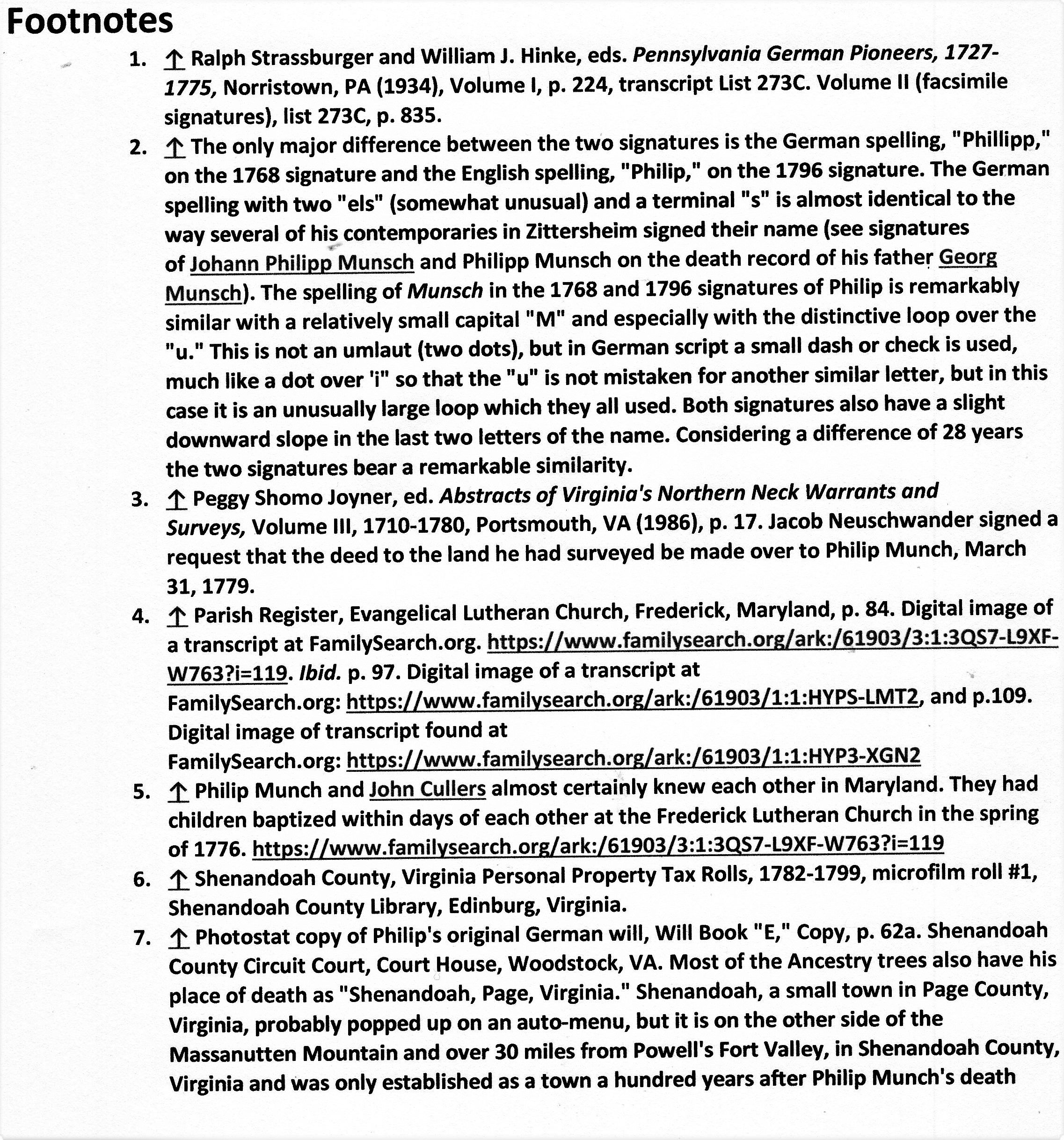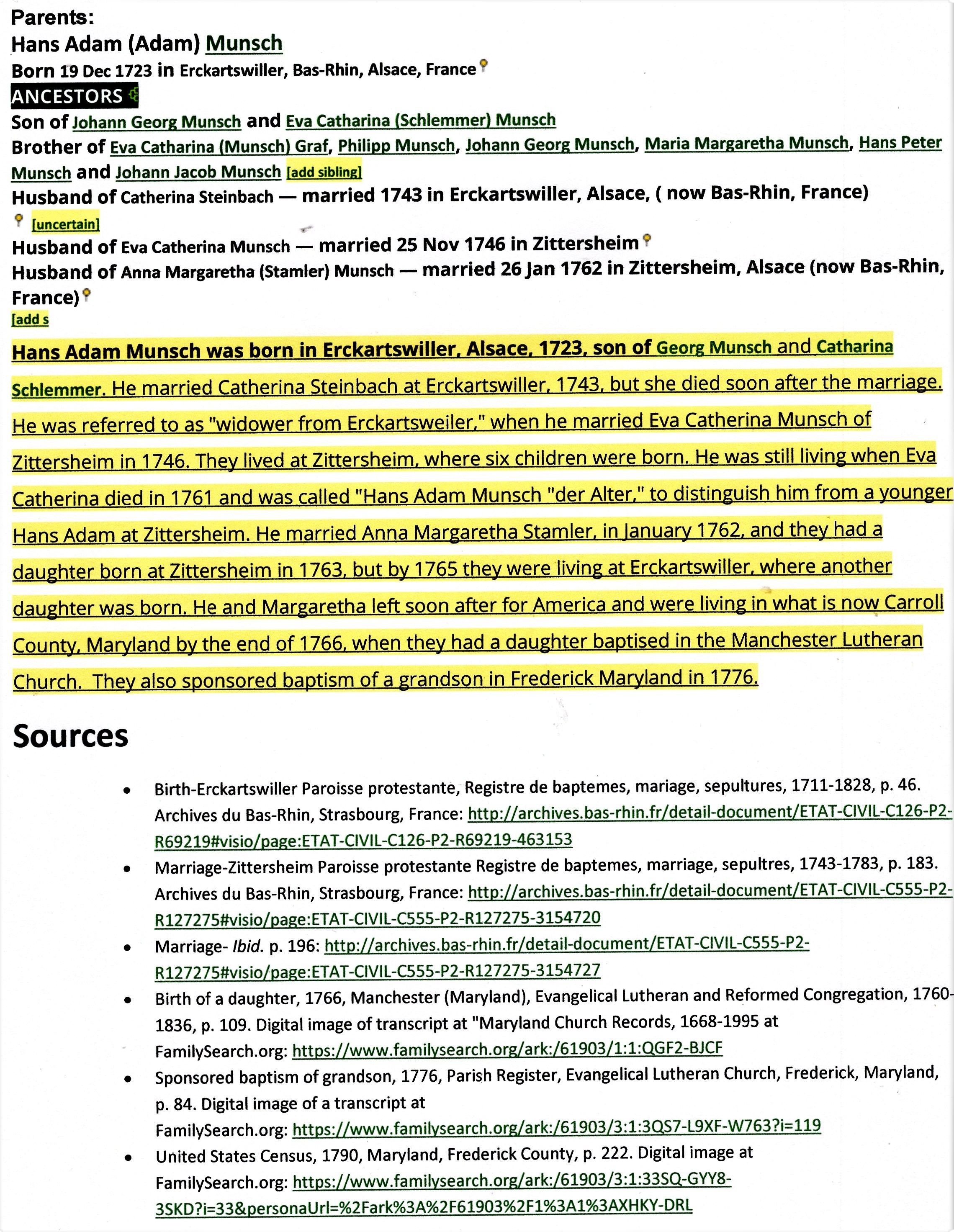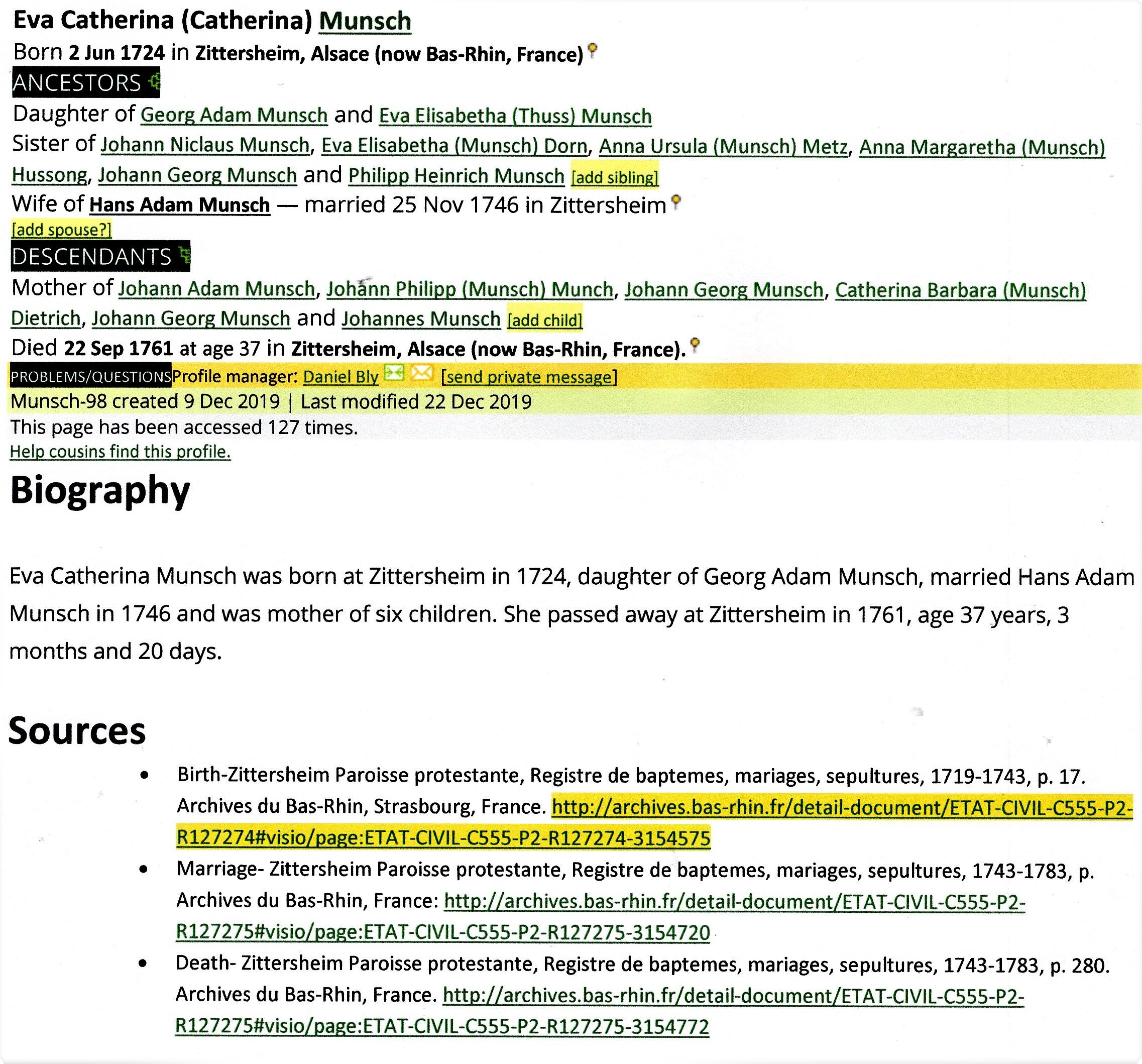Peter, Philip and John wound up in Ohio and descendant, Irene Munch, who passed in 1915 gives a good summary on page two of a letter written to her cousin, Lizzie L. Brackney of Anna, Ohio, dated July 15, 1907.
Interment locations for Philipp and for his wife, who died circa 1807-09, have been found in the Munch Family Cemetery at Pelton on Boyer Road in Fort Valley. Acknowledgement to Gathering Roots who advised of their newly found location site. They should be commended for the fine work done in the recent past. Thank you from all the serious "Gravers". Patrick O
NEW RESEARCH:
Patrick,
I am sending you the biography of Johann Philipp Munsch (Philip Munch), which I have posted on WikiTree. Along with what I have about his wife and his parents. You can follow the links to find more on his ancestors and children.
Daniel Bly, Harrisonburg, VA
The place and date of birth for Philip Munch, who settled on Passage Creek in the "Fort Valley" of Shenandoah County, Virginia, in the late eighteenth century was lost over the years, but family tradition among his descendants is that he was German speaking from Alsace, which was under French rule when he was born. Some have suggested that he is the "Philipp Munsch" who arrived in Philadelphia, October 26, 1768 aboard the ship Betsy.[1] There is now solid evidence that this "Philipp Munsch," the only Philipp Munsch on any eighteenth century ship list, is indeed, Philip Munch of Shenandoah County, Virginia, who signed his name on a 1793 petition and on his will as "Philip Munsch."[2] It is also possible to identify Philip's Alsatian homeland. There was a large Munsch family at Zittersheim and Erckartswiller in the northwest corner of Alsace in the 17th and 18th century. This is an area where there was large scale immigration to America, including the Reitenauer / Ridenour family that settled in the "Fort Valley" of Shenandoah County about the same time Philip Munsch settled in "The Fort." There were at least four Philipp Munsches born in these villages between 1738 and 1750, the time frame in which Philipp Munsch, of Virginia was probably born. Three of these can be eliminated because they died young or married and remained in Alsace. However, Johann Philipp Munsch, born at Zittersheim, January 12, 1749, son of Johann Adam and Eva Catherina, did not die or marry there and cannot be found in any records there after 1768 and his father, Johann Adam, also immigrated with his second wife, and shows up in Frederick County, Maryland by 1766. Philipp Munsch was an ideal candidate for emigration. He was a second son, his mother died when he was young, his father remarried and moved to Erckartswiller and had no particular status in the community and also emigrated. The fact that Philip Munsch in Virginia named his oldest daughter Catherine, and sons; George, Adam, Philip, Peter, and John, all the most common names used by the Munsches of Zittersheim and Erckartswiller, further supports the conclusion that he is Philipp Munsch, son of Adam and Catherina.
Philip Munch remained behind when his father left for America in 1765, but three years later, he too left his homeland and arrived in Philadelphia in October 1768. He does not appear in Shenandoah County, Virginia, until 1779, when Jacob Neuschwander sold him a warrant to 222 acres of land in Powell's Fort Valley, which Neuschwander had surveyed in 1778. [3] He apparently did not spend any time in Pennsylvania, but quickly joined his father in Maryland, married about 1773 and was living in Frederick County, Maryland by 1774, and had three children baptized there. [4] He then moved to Virginia with his young family in 1778-79 to Powell's Fort Valley in Shenandoah County Virginia about the same time the Cullers and Ritenour families also moved from Maryland to the Fort Valley. [5] In 1783 Philip Munch appears in Shenandoah County with six people in the household and in 1785 Philip Munch was included in a list of "Fort Valley" families in a Shenandoah County census, with seven people in his household. He appears to have occupied the 222 acres in Powell's Fort from the time he acquired it. There was some conflict over Fairfax grants and not until the Fairfax-Hite suit was settled did Philip Munch finally get confirmation of his patent in April 1796. The personal property and tithe listing for Shenandoah County show Philip Munch with only one person over age 21 (himself), and no one between 16 and 21 from the earliest records until 1794, when he also had one male in the 16 to 21 age range and in 1796, two males between 16 and 21.[6] Philip became ill in the fall of 1796 and wrote a will in German, October 2, 1796. He began by saying " I, Philip Munsch sense that my end is near, therefore, I must go hence, and I am determined to write my last will and testament in my own hand." He mentioned that his wife was to care for the children until they came of age but did not name them. He then signed his will "Philip Munsch." The will was translated by David Jordan and probated December 14, 1796. His widow, Magdalena, along with his neighbor, David McInturff, was administrator of his will. [7] Philip Munch implied in his will that all his children were still underage and this is confirmed by personal property tax records. They were parents of ten children, one died young but nine survived into adulthood. When Magdalena wrote a will in February 1807, she named three daughters and two sons who were still living at home. The nine surviving children are named in a deed dated March 11, 1811, involving the land inherited from their father.
Peter, Philip and John wound up in Ohio and descendant, Irene Munch, who passed in 1915 gives a good summary on page two of a letter written to her cousin, Lizzie L. Brackney of Anna, Ohio, dated July 15, 1907.
Interment locations for Philipp and for his wife, who died circa 1807-09, have been found in the Munch Family Cemetery at Pelton on Boyer Road in Fort Valley. Acknowledgement to Gathering Roots who advised of their newly found location site. They should be commended for the fine work done in the recent past. Thank you from all the serious "Gravers". Patrick O
NEW RESEARCH:
Patrick,
I am sending you the biography of Johann Philipp Munsch (Philip Munch), which I have posted on WikiTree. Along with what I have about his wife and his parents. You can follow the links to find more on his ancestors and children.
Daniel Bly, Harrisonburg, VA
The place and date of birth for Philip Munch, who settled on Passage Creek in the "Fort Valley" of Shenandoah County, Virginia, in the late eighteenth century was lost over the years, but family tradition among his descendants is that he was German speaking from Alsace, which was under French rule when he was born. Some have suggested that he is the "Philipp Munsch" who arrived in Philadelphia, October 26, 1768 aboard the ship Betsy.[1] There is now solid evidence that this "Philipp Munsch," the only Philipp Munsch on any eighteenth century ship list, is indeed, Philip Munch of Shenandoah County, Virginia, who signed his name on a 1793 petition and on his will as "Philip Munsch."[2] It is also possible to identify Philip's Alsatian homeland. There was a large Munsch family at Zittersheim and Erckartswiller in the northwest corner of Alsace in the 17th and 18th century. This is an area where there was large scale immigration to America, including the Reitenauer / Ridenour family that settled in the "Fort Valley" of Shenandoah County about the same time Philip Munsch settled in "The Fort." There were at least four Philipp Munsches born in these villages between 1738 and 1750, the time frame in which Philipp Munsch, of Virginia was probably born. Three of these can be eliminated because they died young or married and remained in Alsace. However, Johann Philipp Munsch, born at Zittersheim, January 12, 1749, son of Johann Adam and Eva Catherina, did not die or marry there and cannot be found in any records there after 1768 and his father, Johann Adam, also immigrated with his second wife, and shows up in Frederick County, Maryland by 1766. Philipp Munsch was an ideal candidate for emigration. He was a second son, his mother died when he was young, his father remarried and moved to Erckartswiller and had no particular status in the community and also emigrated. The fact that Philip Munsch in Virginia named his oldest daughter Catherine, and sons; George, Adam, Philip, Peter, and John, all the most common names used by the Munsches of Zittersheim and Erckartswiller, further supports the conclusion that he is Philipp Munsch, son of Adam and Catherina.
Philip Munch remained behind when his father left for America in 1765, but three years later, he too left his homeland and arrived in Philadelphia in October 1768. He does not appear in Shenandoah County, Virginia, until 1779, when Jacob Neuschwander sold him a warrant to 222 acres of land in Powell's Fort Valley, which Neuschwander had surveyed in 1778. [3] He apparently did not spend any time in Pennsylvania, but quickly joined his father in Maryland, married about 1773 and was living in Frederick County, Maryland by 1774, and had three children baptized there. [4] He then moved to Virginia with his young family in 1778-79 to Powell's Fort Valley in Shenandoah County Virginia about the same time the Cullers and Ritenour families also moved from Maryland to the Fort Valley. [5] In 1783 Philip Munch appears in Shenandoah County with six people in the household and in 1785 Philip Munch was included in a list of "Fort Valley" families in a Shenandoah County census, with seven people in his household. He appears to have occupied the 222 acres in Powell's Fort from the time he acquired it. There was some conflict over Fairfax grants and not until the Fairfax-Hite suit was settled did Philip Munch finally get confirmation of his patent in April 1796. The personal property and tithe listing for Shenandoah County show Philip Munch with only one person over age 21 (himself), and no one between 16 and 21 from the earliest records until 1794, when he also had one male in the 16 to 21 age range and in 1796, two males between 16 and 21.[6] Philip became ill in the fall of 1796 and wrote a will in German, October 2, 1796. He began by saying " I, Philip Munsch sense that my end is near, therefore, I must go hence, and I am determined to write my last will and testament in my own hand." He mentioned that his wife was to care for the children until they came of age but did not name them. He then signed his will "Philip Munsch." The will was translated by David Jordan and probated December 14, 1796. His widow, Magdalena, along with his neighbor, David McInturff, was administrator of his will. [7] Philip Munch implied in his will that all his children were still underage and this is confirmed by personal property tax records. They were parents of ten children, one died young but nine survived into adulthood. When Magdalena wrote a will in February 1807, she named three daughters and two sons who were still living at home. The nine surviving children are named in a deed dated March 11, 1811, involving the land inherited from their father.










